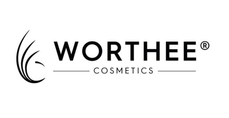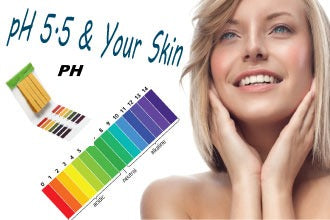Consumers begin paying attention to skincare with pH 5.5 (or mild acidic) when some famous beauty brands market this pH as the friendliest for skin.
Does our skin really favour mild acidic formulations as compared to other pH ranges? Are all products with pH 5.5 gentler and more effective than the others? What do research say regarding pH of products and our skin?

What is pH?
There are many articles flooding on the internet advocating people to use products with pH 5.5, when the authors have zero knowledge about what pH is beforehand. These articles are clearly written by writers without a cosmetic science background.
When we say pH, we are referring to the concentration of hydrogen ions in a solution (pH is the abbreviation for the Latin term “potentia hydrogenii”, which means hydrogen ion concentration). As the hydrogen ion concentration increases, pH values decrease (more acidic) and vice versa.
pH value is a number between 0 and 14, with 7 as the neutral point (think pure water), closest to 0 being the most acidic (think battery acid and gastric acid of the stomach), closest to 14 being the most alkaline (think bleaching agent and drain cleanser).

Most cosmetic products are formulated with water and a bunch of other ingredients, including natural ingredients, which all have chemical properties. pH condition is an important factor to take into consideration when we formulate any cosmetic product. Triethanolamine, citric acid, sodium hydroxide and sodium gluconate are safe pH adjusters we commonly use to tailor the pH of a product.
What is the pH of Your Skin?
Your skin isn’t exactly pH 5.5!
In fact, many skin pH values are being reported in literatures, all in the acidic range between pH 4.0 to 7.0.
The researchers confirm your skin’s pH value by first applying a thin layer of pure water and then directly testing the pH via a pH meter or pasting a pH indicator on the skin. In other words, the pH of your skin is indicated by the amount of sweat and sebum on your skin. Thus, even for the same person, the pH indicator will read differently if it tests at a different time or on a different part of the skin.
Typically, dry skin will have a lower pH closer to pH 4.0, whereas oily skin will have a higher pH closer to pH 7.0. And we are again talking about the outermost layer of the skin. The deeper, cell growing layer is actually of neutral pH. Phosphate-buffered saline (PBS), the solution we use to culture and grow cells in laboratories, has a pH of 7.4.
Are Products with Mild Acidic pH Better for Skin?
So the pH of your skin isn’t exactly 5.5. But it is of mild acidic (between pH 4.0 to pH 7.0).
When the claim related to pH 5.5 was out in the market, the main concerned product happened to be the cleansers. Traditional cleansers are of soap-based, with pH value closer to 10. The smart marketing team behind these brands releasing a different cleanser of pH 5.5, thus making it a spotlight, segmenting their new product as unique, so it can sell better.
But what really happens when you use a soap-based cleanser with pH 10?
Research data showed us that immediately after cleansing with a soap, your skin’s pH is 8, after 30 minutes, it becomes pH 7. It returns back to the original mild acidic pH in just an hour. Faster when you apply a non-irritating, gentle toner after cleansing your face. Likewise, putting on an AHA or BHA exfoliant restores the skin pH rapidly too. So, pH of the cleanser never really matters, as your skin quickly restores to pH of its own in a short time.

What matters most is the cleansing ability of the cleanser. We don’t recommend using soap-based cleansers too, not because the pH is not 5.5, but it is so harsh. It strips the skin barrier brutally. Unless you have a face of excess oil, very oily skin, you don’t need a soap-based cleanser.
Don’t judge a cleanser by its pH. The surfactants (or cleansing agents), texture and other ingredients (non-irritating for the must) tell you the quality of the cleanser better than just looking at its pH.

Paula’s Choice cleansers are all of gentle, skin-friendliest pH, but you never see this company making the pH claim extensively in their marketing, like it’s an enormous issue. Formulating the cleansers around in mild acidic pH is all right because i) the gentle surfactants (or cleansing agents) used cleansers are more stable under this pH ii) microbes hardly survive under this pH. But pH isn’t the only yardstick to decide if a cleanser is great for your skin. Generally, heartiest brands make products of certain pH because of concerns for product stability, effectiveness and efficacy, absolutely not marketing.
Besides cleansers, should all other products be formulated in mild acidic pH too?
Each cosmetic ingredient has its optimal conditions for best performance within a formulation. No experienced chemist will forcefully adjust the pH for all products to be 5.5, if this pH isn’t the best fit for the product.

For instance, the pure form of vitamin C, L-ascorbic acid, stays most potent in acidic pH between 2.5 and 3.5. Another vitamin C derivative, magnesium ascorbyl phosphate, performs best in a mild alkaline formulation between pH 7.0 and pH 8.5. Blindly making the products pH 5.5 will rapidly degrade these active ingredients, rendering their skin whitening ability useless before you apply the product on your skin.
Conclusion is, you don’t have to be so concerned if a product comes in pH 5.5. Cosmetic chemists in the labs have pondered over everything thoroughly before deciding the best pH for any product. And the best product must not always come in pH 5.5.



1 comment
Thanks for your important information. I eagerly want to know about these. Again, thanks a lot.